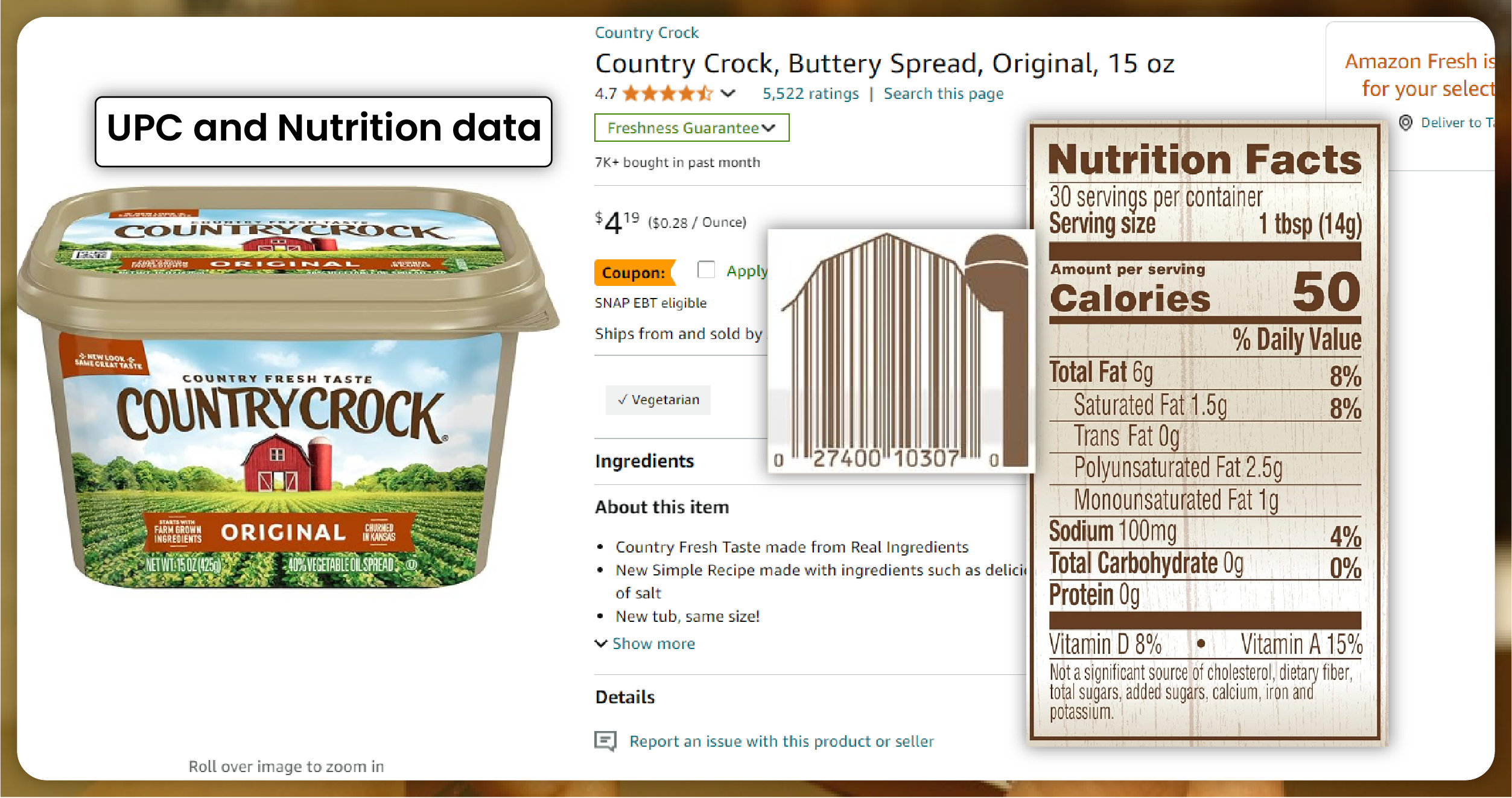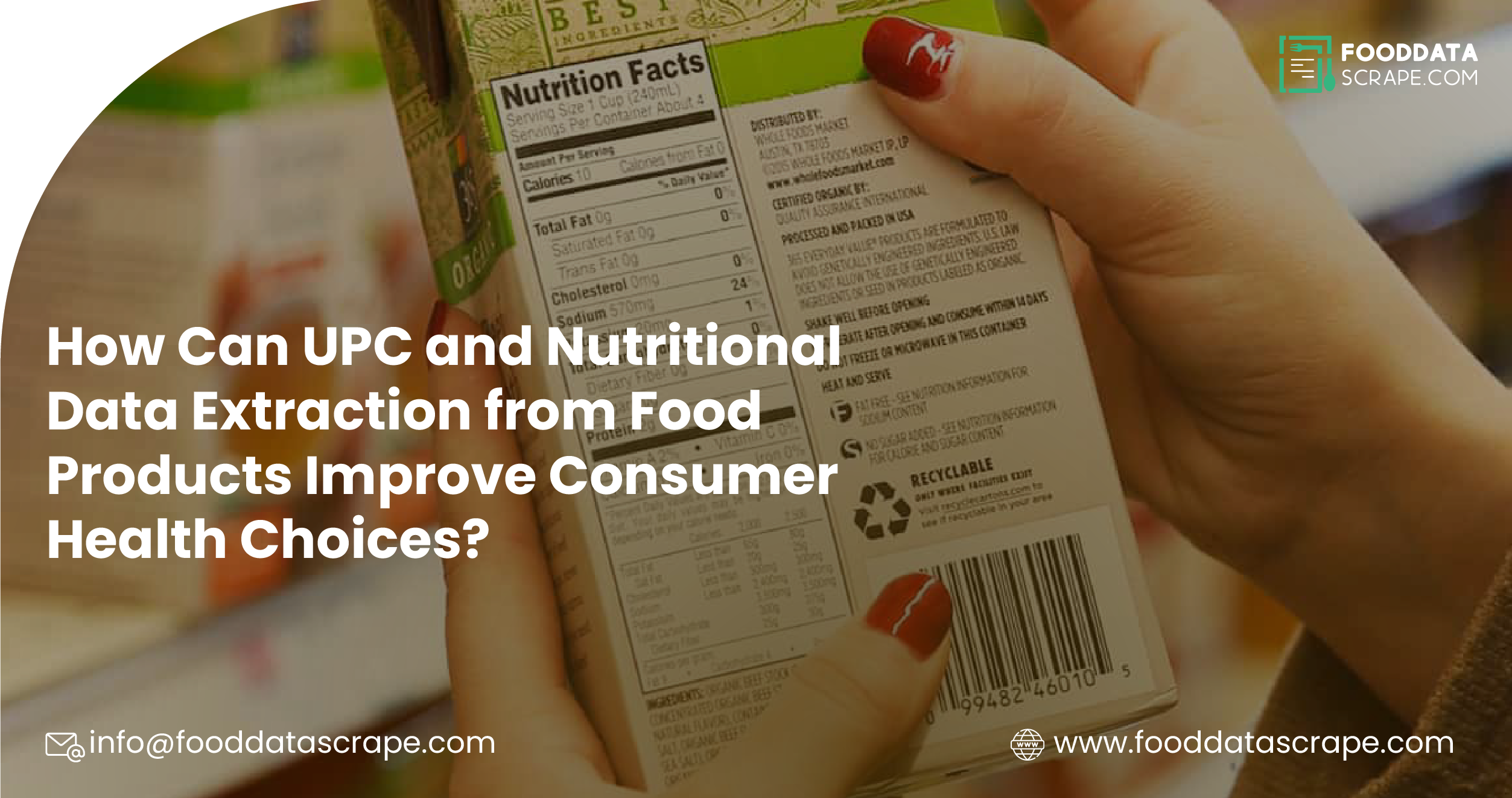With increased health-conscious and convenience-oriented consumers, precise product details are crucial in today's fast world. Some significant needs are the UPC and nutritional data for a food product. UPC and Nutritional data extraction from food products is vital for streamlined inventory management, sales tracking, and identification of products. UPCs will allow retailers to maintain smooth operations, while the nutritional data will help people make informed selections about diet. As concerns for human health rise, the need to know about food products also rises, and clarity in food labeling has lately drawn much attention.
At this moment, Scraping UPC and Nutritional data from food products has proved to be significant across retail, healthcare, and food technology fields. Extracting UPC and Nutritional data from food products helps companies harvest crucial information that involves people's purchases and will be able to put out optimized product offerings, thereby catering to a higher degree of customer satisfaction and, in turn, leading to a wiser and healthier population. The success of meeting consumer expectations in the ever-changing food landscape will also depend on accurate data extraction.
Understanding UPC and Its Importance

The Universal Product Code, or UPC, is a barcode symbology that will be present in stores worldwide. It is to record trade items, and it is composed of 12 numeric digits. The UPC is in the form of a barcode that would typically be scanned rapidly at checkout points. There are several significant functions that the UPC provides:
1. Inventory Management: UPCs help retailers manage inventory operations efficiently. By scanning products at the point of sale, businesses can track sales trends, monitor stock levels, and forecast demand more accurately. Data collection for food products is enhanced by UPCs so that such products are sold out efficiently in the market.
2. Sales Tracking: One can get sales data in complete precision with the help of UPC. Hence, it helps retailers analyze which products are most likable to their consumers and which are not. Businesses find this data-driven approach and adjust their marketing policies according to market preferences and optimize product offerings based on consumer preferences, for which Nutritional data scraping for food items might be of great use for understanding market dynamics.
3. Product Identification: Using UPCs would ensure that the products have proper identification in a retailer's inventory system. This is especially important in large stores carrying thousands of items, where quick and accurate product identification is essential. Employing web scraping of food items and nutritional data improves product identification accuracy in real-time.
4. Prevention of Fraud: UPCs are crucial tools in preventing counterfeiting and fraud. Unique codes prevent companies from selling genuine products, which increases consumer trust. Food product information extraction is essential to the brand's reputation.
5. Global Standardization: UPCs help in trade globally by enabling standardized and uniform product identification systems. This becomes necessary in a global market where products are sold and shipped across borders. With businesses growing increasingly dependent on technology, they can use methods to extract food product data for better insights and more streamlined operations.
The Role of Scraped Nutritional Data in Boosting Consumer Health Choices

Scraped nutritional data provide essential information about what is in foodstuffs, including macronutrients (carbohydrates, proteins, and fats), micronutrients (vitamins and minerals), and other essential nutrients like fiber and sugars. The significance of nutritional data can be categorized into a few essential categories:
1. Informed Consumer Decisions: As more and more consumers are worried about health, proper nutrition information allows them to make the right nutrition decisions. It is crucial for those with some dietary restraint or a specific objective in health-related parameters, like weight loss or control of chronic diseases. Techniques like web scraping for food product data help effectively gather the required information.
2. Compliance with Law: All food manufacturing companies and stores are bound to display nutritional data in the packaging to meet health legislation requirements. Quality data will ensure that anyone meets all the food labeling legislations. Companies will lose cash for judgments due to court if their product labels do not meet the regulation requirements. Product labels can be guaranteed to pass every required regulation check while scraping food product information is done.
3. Product Development: Food companies must know the nutritional details when developing new products. Companies can evaluate competitors' nutrition profiles for healthier product development, re-formulate current products, or investigate particular dietary markets. Online food product data extraction may allow for competitive data gathering for innovation.
4. Consumer Education: Nutritional information educates consumers on the implications of their diets on health. Equipped with such knowledge, people can make good decisions about nutrition and diet. Extracting food product information from food websites improves consumer access to vital dietary information.
5. Healthier Lifestyle: Nutrition data availability opens possible avenues toward healthful lifestyles. Governments and health organizations tap into available data to improve the population's eating behaviors. Extracting data from food product websites provides comprehensive nutritional information that helps support public health initiatives.
The Process of UPC and Nutritional Data Extraction

Various methodologies for extracting UPC and nutritional data of food products, like web scraping, OCR (optical character recognition), or database querying. The choice is mainly based on the source of the data and the organization's requirements. Some common approaches are explained below:
1. Web Scraping: Most retailers and food manufacturers post details regarding nutrition and even UPC on their websites. Therefore, Nutrition Facts food data scraping is automatically getting this data into tools' web pages. Businesses source data from different online platforms, enabling them to collect the most advanced datasets that can be further analyzed to achieve UPC, Brand, Category, and Nutrition data extraction.
2. OCR: Use OCR technology to extract text from images. This lets you capture UPCs and other details usually found on food product packaging. Since it deals with natural items like product labels in stores and warehouses, the method of web data mining for food products comes in very handy.
3. Database Querying: Organizations may use SQL queries to grab UPC and nutritional data directly from their systems because they keep their respective products in proprietary databases. Database querying will ensure accuracy and integrity, especially for large retailers with voluminous product inventories. Thus, reliable food delivery data scraping services require effective querying techniques.
4. Third-Party APIs: Several third-party services offer UPC and nutrition data in databases that companies can access through APIs integrated into their systems. Using third-party APIs helps avoid the headache of maintaining in-house data collection processes, thereby providing real-time information to the business for more effortless engagement with nutritional insights.
Applications of Extracted Data

The extracted UPC and nutritional data have extensive uses across the industry lines:
1. Retail and E-commerce: The UPC, combined with nutrition data, enables retailers to provide better efficiency in their inventory system, optimize their supply chain management process, and enhance customer experience. With such precise nutrition data available online, health-conscious buyers are attracted, and transparency is encouraged. Web scraping food delivery data collects insights into customer preferences and inventory trends effectively from a business perspective.
2. Health: Nutrition specialists and dietitians can apply nutrition data to design specific patient diets. Health professionals can analyze dietary patterns and suggest specific changes from massive food databases. Restaurant menu data scraping will assure health practitioners that their diet advice is based on the latest and most accurate food facts.
3. Food Tech: Those businesses in food tech scan UPCs and nutrition data to create applications and websites that consumers can utilize for healthier nutritional choices. Such technologies help people track nutritional consumption, get recipes based on available ingredients, and find healthier substitutes for favorite foods. Thus, food delivery scraping API services enrich the experience through integrating nutrition data into these applications.
4. Regulatory Bodies: Regulatory authorities and other government agencies use nutrition data to enforce food labeling and regulatory policies targeting public health. They may also use information on consumption patterns to inform policies that enhance positive health outcomes from consumption. Food delivery intelligence services can help trace trends in food consumption and public health trends.
5. Market Study: UPC and nutrition data help companies conduct market studies, analyzing trends in consumer choices. This further helps to plan strategic decisions regarding products, marketing programs, and price strategies. Restaurant data intelligence services facilitates a company's decision-making by offering valuable perceptions.
Challenges in Data Extraction

Indeed, extracting UPC and nutritional information has several advantages but has associated challenges:
1. Data Quality: Data withdrawn from a given system must ensure accuracy and consistency. Only accurate and consistent data are prone to result in poor decisions, hence affecting consumer confidence.
2. Data Volume: Most food products produce vast amounts of data. Such organizations will require effective systems for managing and analyzing this data.
3. Legal Compliance: Food labeling rules for manufacturers and retailers also change. Firms should ensure their data extraction processes comply with all the country's legal requirements.
4. Data Privacy Concerns: Data privacy issues exist regarding consumer preference and eating habits data collection. Organizations must handle personal data responsibly and by regulatory bodies to protect the rights of data subjects.
Conclusion
The extraction of UPC and nutritional data related to food products cuts across retail, healthcare, and much else. With continued calls for better health and improved transparency, businesses are now more critical than ever to use the correct data about these ideals. Using modern technologies in UPC and Nutritional data extraction from food products and analysis, businesses can derive more critical insights into optimizing their product offerings and helping consumers make the right dietary choices. Tools such as a food price dashboard are also available to help businesses stay up-to-date with changing trends and competition in pricing, which is one more enhancement to their market strategies. Because the value of information continues to grow, the ability to access and apply UPC and nutrition knowledge will continue to be essential competence for food organizations and much more.
If you are seeking for a reliable data scraping services, Food Data Scrape is at your service. We hold prominence in Food Data Aggregator and mobile restaurant application scraping with impeccable data analysis for strategic decision-making.



























































































